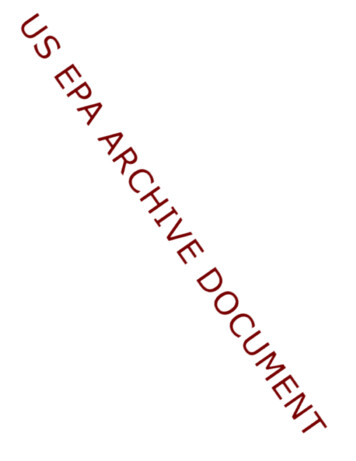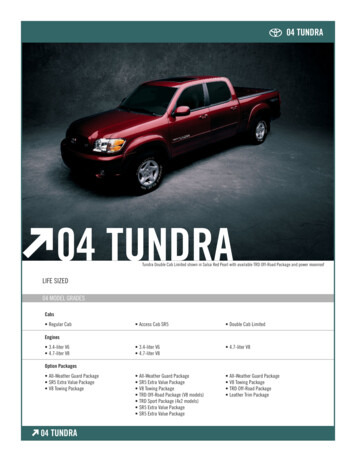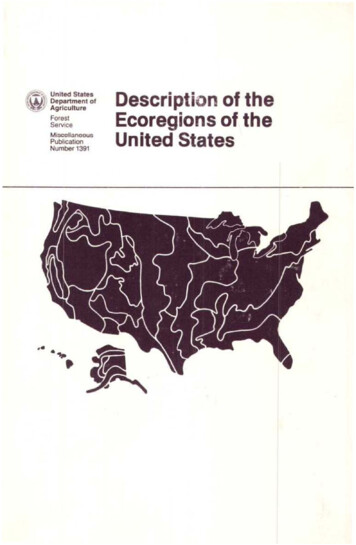
Transcription
Tundra Treatment GuidelinesFreshwater Spill SymposiumThomas R. DeRuyter, Amanda J. Leffel, Edward E. MeggertAbstractSpills of oil and other hazardous substances to tundra environments have always beenproblematic for both the responsible party and the regulatory agencies. Aggressivecleanups have left the tundra badly damaged. Areas where no cleanup was attemptedoften exhibit problems based upon product type and concentration. In an attempt tobetter define response tactics and thresholds the Alaska Department of EnvironmentalConservation (ADEC) and Alaska Clean Seas (ACS) initiated a study of the availableliterature and historical case files concerning spills of oil and selected hazardoussubstances to tundra environments. This study culminated in the development of theTundra Treatment Guidelines (TTG). The overall emphasis of response has shifted fromachieving a numerical standard of remaining contamination to a less precise but morepractical goal of rehabilitation of the affected environment. The results of this studydoes not leave behind numerical end points but attempts to redefine those limits at thelevels which allow the tundra to recover as quickly as possible without excessive damagefrom overworking the tundra during cleanup operations.History of Releases Related to Oil Exploration and Production ActivitiesSince the mid 1940’s when the United States Navy began the first large scale coordinatedpetroleum exploration activities in the Naval Petroleum Reserve (currently known as the1
National Petroleum Reserve of Alaska, NPRA) the North Slope of Alaska has continuedto be the site of oil and gas exploration and production. Activities increased dramaticallyafter the discovery of the Prudhoe Bay oil field in the late 1960’s. This was followed bythe Trans-Alaska Pipeline construction activities in the 1970’s and the subsequent oilproduction.Numerous other production and exploration projects have taken place in various areas ofthe North Slope during this period of time. Some of the other major oil reservediscoveries that have lead to production include Milne Point, Kuparuk, Point McIntyre,Lisburne, Endicott, Badami, North Star and Alpine. Smaller “satellite” fields have beendiscovered near the larger reserves and have been developed using the infrastructure thatis in place. A partial listing of these fields include Tarn, Tobasco, Meltwater, andSchrader Bluffs. Additional development of the NPRA is anticipated.All exploration and production drilling, by it’s very nature, requires the transportation,use and handling of large quantities of oil and other liquid hazardous substances tocomplete the operations. Spills or releases of these substances are a common occurrence.The ADEC Spills Data Base has shown that since 1995, 300 to 500 reported releases, peryear, have occurred on the North Slope of Alaska from production and explorationdrilling activities. Equipment failure and human error during the transfer of these liquidsare the two largest documented causes of these unplanned releases.2
In an effort to minimize the number, size and the impacts from oil and hazardoussubstance releases, governmental agencies have required that the oil producers developand maintain contingency plans. These plans not only outline storage and handlingpractices of oil products but also require the producer to maintain enough responsepersonnel and equipment to show that they could recover the worst case scenario releasewithin 72 hours. These contingency plans along with other factors such as cost ofcleanup and the value of public good will have provided the impetus for private industryto create a “culture of environmental awareness” among the oil field workers. Thisawareness along with better-designed equipment and improved handling practices hashad a positive effect on the size, number and environmental impact of releases of oil andhazardous substances.Need for Pre-Approved Response TacticsDuring a 1995 meeting, between the environmental staff of the North Slope oil producersand the State on Scene Coordinator (SOSC) for the ADEC Northern Area ResponseTeam (NART), a conceptual idea of developing a set of scripted response tactics forspills on the North Slope, that would be pre-approved by the State of Alaska, was firstconsidered. This consideration by the SOSC was made with the knowledge that less timewould be spent on the North Slope by ADEC response personnel to make fieldjudgements on the appropriateness of individual response tactics. All parties recognizedthat having appropriate, pre-approved tactics would avoid delays in seeking agencyapproval thus minimizing environmental damage that could be caused by migrating oil orhazardous substances. It was also recognized that a large volume of historical3
information existed in a variety of locations that could be used to predict that efficacy ofthe response tactic.Development of the Alaska Clean Seas Technical ManualPrior to funding authorization of the TTG and independent of its development, ACS, thespill response cooperative owned by the North Slope oil producers, began work on theAlaska Clean Seas Technical Manual. ACS developed this document in cooperation witha variety of agencies from the local, state and federal government, and also privatecorporations including Alyeska Pipeline Service Company, BP Exploration (Alaska) Inc.,and ARCO Alaska Inc. One of the main functions of this document was to describe theresources that would be needed and the tactic that would be used to respond to a varietyof spill scenarios. These resource requirements and tactics were individually labeled andthen referenced in the contingency plan that the oil producers held with the ADEC.These described tactics not only serve to fulfill contingency plan requirements but alsofunction during an actual spill event to quickly and effectively communicate togovernmental agencies the type of response tactic that is planned. Alaska StateRegulation 18 AAC 75.310 requires a responsible party to use approved responsemethods for all individual spill sites. Using tactics that have gone through a prior reviewand approval process with ADEC reduces the chance for miscommunication andapproval delays between the response organization and ADEC.4
Conceptual Development of the Tundra Treatment GuidelinesADEC was able to provide funding for additional research and project developmentshortly after the initiation of the ACS Technical Manual. It was decided by ADEC thatdue to the nature of tundra being damaged from minimal disturbance, that specificinformation was required to address spill cleanup in the tundra environment. Both ADECand ACS committed financially resources to address this issue.It was recognized by private industry, response contractors and governmental agenciesthat responding to oil and hazardous substance releases on tundra required specific tacticsand techniques to minimize damage to tundra from both the contaminate and the responseitself. It was noted from prior spill cleanup activities on the North Slope that tundra cannot only be damaged from the spilled substance but also from excessive foot traffic of theresponse personnel, equipment, and excessive response actions. It was the recognition ofthese problems that the TTG attempted to minimize by directing response personnel touse pre-described methods. These methods developed were based upon knowledgegained from previous response, cleanup and restoration activities.The first objective of ADEC was to set general goals for response action. The threegoals were 1. Minimize damage to the tundra from the spilled material. 2. Minimizedamage to the tundra from the response actions. 3. Minimize the recovery period of thetundra. These goals were the main objectives of each tundra cleanup that was attempted.However the response methods had not been subjected to the rigors of in-depth reviewusing historical information from past spill events to judge their effectiveness.5
Compilation and Interpretation of DataSpill files were developed and kept on notable spills from the mid 1970’s. In an attemptto improve documentation of the reported releases the ADEC Northern Region Office(NRO) began compiling and storing spill information in a database format in 1981.Many individual spill records from 1973 through 1981 were back entered into thedatabase after its inception. The database format was used by ADEC on a statewideeffort following a structural reorganization in 1995. This Spills Database along with asystematic approach to storage of individual spill files has provided an excellent resourcefor retrieving information from individual spill events across the North Slope.According to the ADEC Spills Database approximately 2,000-2,500 spills of oil andhazardous substances occur every year in Alaska. For the purpose of definingremediation tactics, ADEC identified five main categories of substances that may bespilled on the North Slope. These categories are crude oil, refined petroleum products,saline waters, drilling fluids and synthetic fluids (i.e. glycol and methanol). Thesecategories were based on the types of activity that is common to the North Slope region.This includes oil and mining activities, delivery of fuel to villages, and the transport of oiland hazardous substances along the highway.AMEC Earth & Environmental was tasked with evaluating and summarizing availableinformation concerning spills in tundra environments, subsequent response efforts, andthe ultimate results of the response. There was an information-gathering phase,construction of a database to catalog and analyze the information, and development of6
five generalized spill scenarios to support and communicate the lessons learned by thisapproach. Information was collected from ADEC files, BP Exploration (Alaska) Inc. andAtlantic Richfield Company (ARCO) spill databases, and case study information.There are different types of tundra that may be found on the North Slope. These includeaquatic tundra, wet tundra, moist tundra, and dry tundra. The common characteristicsthat segregate these types are defined in Table 1.Tundra TypeTypical TopographyAQUATIC TUNDRAPonds, lakes, or streamsWET TUNDRACoastal or low areasMOIST TUNDRAFoothills, gentle slopesDRY TUNDRAMountains, steep slopes,bluffs and riverbanksSoil ConditionsSediment under shallowwater, organicaccumulationsVegetative GrowthAquatic sedges, grasses,and forbesSoil saturated, standingwater often present, thickroot and organic layerPrimarily emergentaquatic grasses andsedgesWell-drained to saturated Includes tussock tundra,soil. Dense root mat withgrass meadows, lowsome organicsshrubs, and some forbesWell-drained, exposed,rocky, or barren locationwith little root mat ororganicsSparse, often low-lyingplants such as matforming heathers,cushions plants, lichens,and mossesTable 1.It is quite likely that when a spill occurs, tactics to cleanup, remediate or promoterecovery may need to address more than one tundra type.Current Use of the Tundra Treatment ManualThere are several factors that need to be taken into consideration that will affect spill fateand effects. A logical approach exists to develop treatment goals and strategies. This isclearly defined in Table 2.7
Table 2.In addition to looking at the receiving environment, properties of the substance spilledmust be considered. There are a number of factors affecting spill fate and response in8
tundra environments. Such properties include solubility, viscosity, specific gravity,volatility, freezing point, biodegradability, toxicity, and the temperature of the spilledsubstance. Time of year also plays a role in the determination of tactics used to respondto spills.As described above, time of year also will affect the fate and effects of spills in tundraenvironments. Table 3 summarizes the factors that most influence spill fate and effectsduring frozen conditions (winter and freezeup) and melted or melting conditions (summerand spring thaw).SeasonClimatic VariableProperties of theSpilled SubstanceCharacteristics of theTundra TypeWinter/FreezeupSnow depthWindAir temperatureTemperature when spilledFreezing pointViscositySlopeWater solubilitySpecific gravityVolatilityBiodegradabilitySlopeDrainage patternsSurface and standing waterSoil type and saturationVegetative coverSummer/ Active layer depthSpring Thaw Air temperatureSoil TemperatureGrowing SeasonTable 3.The five stereotypical spill descriptions include a wide range of approaches identifiedduring the initial, short term and long term response actions. Decisions on what approachis the most effective for cleaning up a spill to tundra may be found by following thedecision trees found below (Diagrams 1, 2, 3).9
Diagram 1.10
Diagram 2.11
Diagram 3.12
There are a number of tactics associated with each part of the decision tree. There arethree types of tactics that the above decision tree lists: Planning Tactics (P), TreatmentTactics (T) and the Assessment and Monitoring Tactics (AM). For example, P-4,5 refersyou to the planning tactics section that describes “minimizing physical damage totundra” and “tundra travel”. Other such tactics include flooding, flushing withsurfactants, land barriers, sorbents, drainage protection, recovery with skimmers andpumps, and many more. Under each tactic there is a description of the proposed tactic,the applicability of the tactic (spilled substance, tundra type, and season), considerationsand limitations of the tactic, and the equipment, materials and personnel to deploy thetactic.Use of Documented Restoration Levels in Cleanup Actions.The production of the TTG resulted in a major shift for spill site closure actions from theADEC. Closure is now based on restoration rather than achieving a numerical value.The TTG defines conditions under which restoration and re-growth are most likely tooccur following a spill event. Although the decision tree for cleanup actions still listsnumerical standards, they are not used for site closure. They are intended to be used asaction levels during the response phase following a spill. Based upon the compilation ofinformation made for the TTG it was established that if contaminate levels exceed thesevalues it can be expected that moderate to sever tundra damage will occur.This effort has lead ADEC through an evolutionary process to develop standards foracceptable levels of remaining site contaminate. This process continues today. The TTG13
has become a resource in that process. A matrix was developed in the early 1990’s forpetroleum cleanup levels based upon the type of product and the receiving environment.This matrix was used as a guidance document in site closure until 1997 when ADECpromulgated regulations that included this matrix, now known as method one, and a setof cleanup levels based upon risk to human health into regulation. The method onematrix continues to be used for site closure following spills of petroleum based productsto North Slope gravel pads but does not address tundra.Application of only the regulatory human health cleanup standards for petroleumcontaminates would leave contaminate levels high enough to kill much of the tundravegetation. With the method one matrix not addressing tundra, and human healthstandards too high for environmental protection, it left cleanup levels to be set on a siteby site bases. This becomes an expensive and time-consuming exercise. The TTG bringsinformation together from past research and spill events so that cleanup levels can beestablished and used on the entire North Slope tundra environment.The TTG was first applied to an incident that occurred in April 2001, at the Kuparuk OilField Central Processing Facility, North Slope, Alaska. An estimated 92,400 gallons ofproduced water containing 554 gallons of crude oil spilled all to tundra. The release wasdue to external line corrosion. The technique used to remove the oil and salt water(produced water) consisted of more than one tactic as outlined in the TTG. A regime ofhot water flushing, thermoremediation (burning) and detergent washing wasimplemented. As expected, it took multiple flushing events to loosen and remove the14
crude oil from the tundra vegetation. The areas of the spill site that did not containfloating crude took less effort to remove the produced water but the removal techniquesremained the same. Conductivity (salt levels) and hydrocarbon testing was conducted inall areas of the spill site. Target levels for conductivity were 3 mmhos/cm, TPH 13,000 mg/kg and diesel range organics (DRO) 1,000 mg/kg. It was with the aid ofthe TTG that the spill site was cleaned up to a standard that allowed for optimal regrowth/regeneration of the tundra.Future DevelopmentDuring November 2001, in the western operating area of the Prudhoe Bay reserve, a1,764 gallon mix of hydrochloric acid, xylenes, freshwater, and corrosion inhibitorspilled all to tundra. The cause of the release was a tanker truck that rolled off the roadand spilled all of the contents of the first compartment and some from the secondcompartment. This mixture of chemicals is typically used down hole in an oil well toremove all materials that, over time, has built up on the pipeline casing that may beimpeding flow and production. It became apparent that a spill of this type to tundra, hasnot been documented in the past, and that no set cleanup tactics ever developed. This isan obvious informational gap in the TTG. Eventually tactics were developed andimplemented, and the spill cleaned up. Damage to the tundra may be extreme in thiscase, so the better development of initial, short term and long term response tactics arewarranted.15
It has become apparent that this document is an excellent tool in developing site-specificresponse strategies to oil and hazardous substance spills to tundra. It was designed to bea dynamic and living document in that additional information from research and futurespill events can easily be incorporated. It is intended that the TTG will be maintained onthe ADEC website so that the latest version can be downloaded for free.ReferencesAthey, P., J. Conn, J. Lukin, J. McKendrick, D. Reeder, Tundra Treatment Guidelines, AManual for Treating Oil and Hazardous Substance Spills to Tundra, State ofAlaska Department of Environmental Conservation, Oasis Environmental, Inc.,Lazy Mountain Research, and Lukin Publications Management, 2001.Behr-Andres, C., J. Conn, S. Forester, and J. Wiegers, Tundra Spill Cleanup andRemediation Tactics: A Study of Historic Spills and Literature, AMEC Earth &Environmental and State of Alaska Department of Environmental Conservation,2001.16
Tundra Treatment Guidelines Freshwater Spill Symposium Thomas R. DeRuyter, Amanda J. Leffel, Edward E. Meggert Abstract Spills of oil and other hazardous substances to tundra environments have always been problematic for both the responsible party and the regulatory agencies. Aggressive cleanups have left the tundra badly damaged.










